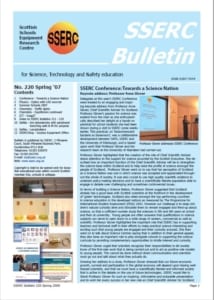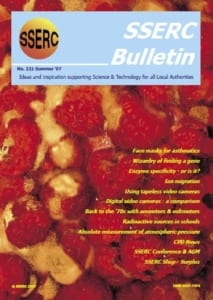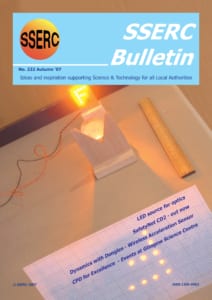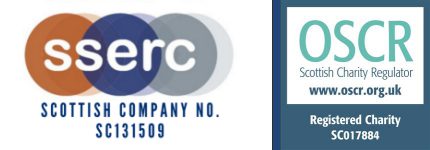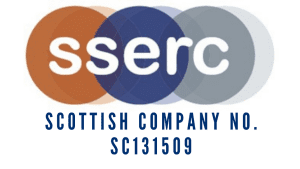p1 Conference – Towards a Science Nation
Delegates at this year’s SSERC Conference were treated to an engaging and inspiring keynote address from Professor Anne Glover, Chief Scientific Adviser for Scotland.
p2 Physics – Optics with LED sources
The conventional raybox source – a 12 V, 24 W tungsten filament lamp with vertical filament – has disadvantages. Its radiation is redder than normal sunlight and, because the light diverges in all directions, only a tiny fraction is made use of. Also the lamp is less than 15% efficient and its relatively high wattage can cause the lamphouse to get rather hot. In principle a white LED should do better. It is an efficient, very-low power source whose radiation can be highly directional and match the colour content of sunlight.
p4 Summer Schools 2007
This is a variation on the classic Blue Bottle experiment. Here the methylene blue is replaced by indigo carmine which gives a two-stage colour change..
p6 Chemistry – Equilibrium continued
In SSERC Bulletin 219 we gave details of a simple demonstration showing the effect of temperature change on the position of an equilibrium. Using the solution of cobalt chloride and additional chloride ions the colour change between blue and pink takes place over a particular, smallish temperature range with an intermediate colour of mauve.
Using SnagIT for screen capture.
p8 Index to SSERC Bulletins 211 – 219
p12 SSERC Shop – Surplus Equipment Offers
Health and Safety
p10 Are laboratories with peripheral benching safe & fit for purpose
We were sent a tip by Inverclyde Council on a means of preventing mains lamp-holders such as ones fitted in microscope lamps falling apart.
Obtaining an Absolute Measurement of Atmospheric Pressure
An activity using an inverted bottle of water and a ping pong ball to measure atmospheric pressure. Teaching Focus: Higher Physics (Pressure, Density, Boyle’s Law), Advanced Higher (Investigation)
Back to the Seventies with Ammeters & Voltmeters
We smile wryly at the cars and fashions of the 1970s and are thankful that modern digital meters have removed the necessity for the different circuits. Or have they?
Using Tapeless Video Cameras in Science Classes
Many schools and individual teachers now own digital cameras. This article covers the use of the “video clip” feature found on many of these devices. Note that some cameras are now marketed as “tapeless camcorders”, designed specifically for video work.
Ion migration – copper(II) chromate(VI)
We had some queries from technicians unable to get this demonstration to work. Furthermore we found that some younger technicians and chemistry staff had never even heard of it! It can be used in Standard Grade Chemistry to help show the existence of ions. This method of preparing the solutions and apparatus has stood the test of time.
Enzyme Specificity – or is it?
We have been receiving reports that the Intermediate 2 Biology LO3 experiment “Determination of the Specificity of Enzymes” is causing some difficulties for students. We have been investigating.
Wonderful wizardry of finding a gene
The aim of this activity is to allow pupils to carry out simple gel electrophoresis in order to simulate DNA profiling. The protocol uses mixtures of food colouring instead of DNA. On application of a voltage across the gel, the mixtures separate into bands of their individual colours. Each colour represents a gene for a ‘magic power’ so that this fun protocol allows pupils to identify the ‘magic power genes’ possessed by each of the wizards.
Health and Safety
Radioactive sources in schools
The need for a survey to find out exactly what radioactive materials were being held by schools was recognised some time ago. While preparing to carry out such a survey, SSERC was independently asked by the Environment Agencies (SEPA and the EA) to participate in the Surplus Source Disposal Programme (SSDP), a UK-government initiative. Agreeing to this proposal, the survey has been conducted by SSERC and managed by the SSDP Board, with the support of the Scottish Executive.
Face masks – for asthmatics handling fungal spores etc.
SSERC received an enquiry recently in connection with the use of the SAPS ELISA kit for the detection of Botrytis infection in raspberries. The kit provides specific safety advice on its use. One particular safety point advises that if a user of the kit is asthmatic a face mask should be worn, as fungal spores may be released into the air during the experiment. The enquiry we received focused on what we thought would be the best disposable masks to use for asthmatic students wishing to carry out the experiment, or indeed any other experiment involving fungal spores.
This is what CPD is all about – Summer Schools 2007
Delegates once again rated Summer Schools in biology, chemistry, physics and primary science as highly successful. Funding was provided by the Scottish Executive through the Support for Science Education through CPD project to enable project partners1 to organise and run the events.
Get the most out of your pH meter
A helpful guide to the storage and maintenance of your pH meter(s)
Dynamics with Dongles – A Wireless Acceleration Sensor
The Vernier WDSS (Wireless Dynamics Sensor System) is a wireless sensor that can measure acceleration in 3 axes and has force and altitude sensors. It can also act as a datalogger to record data. Data transfer is wireless, via Bluetooth. The sensor is supplied with Logger Pro software and a Bluetooth dongle that plugs into the USB port of a computer.
We describe the design of an array of 10 LEDs providing you with a source for many types of experiments in optics.
Wizardry of Finding a gene – battery-free
A revision of the experiment in Bulletin 221 but using a power supply rather than 3x9V batteries.
Anabaena cylindrica: Nitrogen deprivation
The activity described below makes use of this easily observed difference between normal vegetative cells and heterocysts to compare heterocyst frequency in Anaebena grown in medium of normal nitrogen levels with that of Anaebena grown in nitrogen-deficient medium.
Goodbye to you my trusted friend…
What sort of a message is this sending out about science education if pupils meet decades-old technology in our subject, then find themselves in front of a state-of-the-art LCD monitor in business studies?
Draft Experiences and Outcomes for Science (CfE)
In September 2007 everyone had their first chance to have a look at the complete new draft experiences and outcomes in Science. Back in 2004 the Curriculum Review Group made a commitment to “update, simplify and prioritise the curriculum, starting with science”. The new draft outcomes are the culmination of that promise.
Suppliers and uses of disposable gas cylinders
Gamma sources and standard school experiments
Evaluation of the Safety, Working life and Effectiveness of three sources for standard experiments.
Photochemical reaction of Hydrogen with Chlorine
A striking explosion, initiated by a flash of light.
Health and Safety
Van de Graaff generator hazards
We have had another look at the safety of the Van de Graaff generator (VDG) in light of new information in electrical standards and from measurements of dome voltage.

